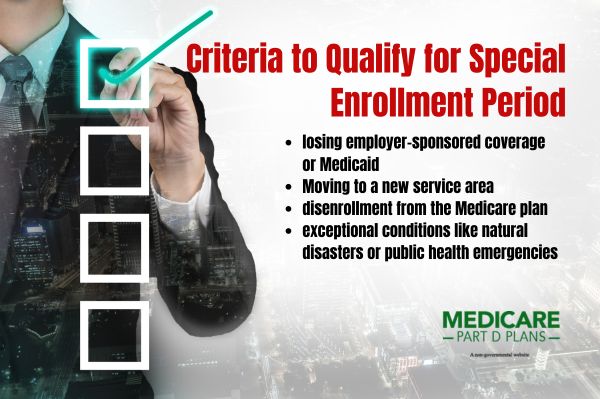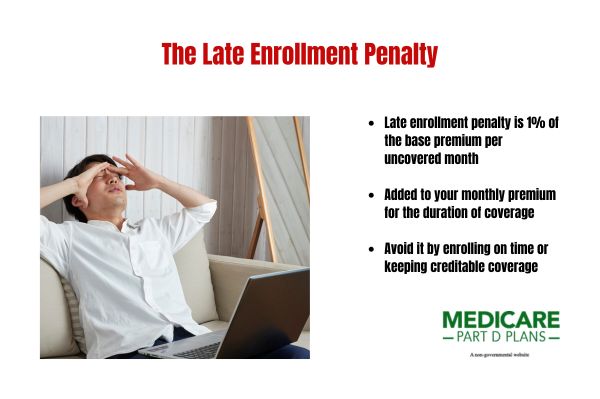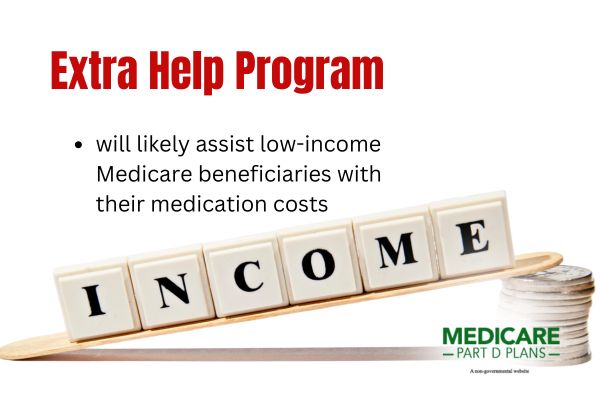Find a Medicare Part D prescription drug plan

Medicare Part D
Prescription Drug Coverage 2026
Medicare Part D Special Enrollment Period
The Medicare Part D Special Enrollment Period (SEP) lets you join or switch prescription drug plans outside normal times. This article covers what qualifies you, how to apply, and what documentation you need.
Key Takeaways
- The Medicare Part D Special Enrollment Period (SEP) allows beneficiaries to adjust their prescription drug plans outside regular enrollment, which will likely be triggered by qualifying life events like losing coverage or moving.
- Proper documentation is essential for a smooth enrollment process during the SEP; beneficiaries should provide evidence of their qualifying event to avoid delays in activating new coverage.
- To avoid the late enrollment penalty, beneficiaries should promptly enroll in a Part D plan upon eligibility or if qualified for a SEP, as this may ensure continuous coverage and potentially reduce costs.
Understanding the Medicare Part D Special Enrollment Period
The Special Enrollment Period (SEP) for Medicare Part D is a crucial timeframe that allows beneficiaries to join or switch prescription drug plans outside the standard enrollment periods.
This flexibility could be vital for ensuring continuous access to necessary medications, particularly when life throws unexpected changes your way.
Knowing when and how to use the Medicare Part D SEP might help to prevent gaps in drug coverage. These periods will likely be designed to accommodate significant life changes that could otherwise leave you without necessary medications. Examples of qualifying life events might include:
- Losing employer coverage
- Moving to a new area
- Experiencing any other qualifying life event
Knowing your SEP options could potentially save you from the stress and financial burden of interrupted coverage.
In essence, the Medicare Part D SEP will likely act as a safety net, providing you with the opportunity to make necessary adjustments to your prescription drug plan when life’s circumstances change. Staying informed about these periods could help ensure your healthcare needs are met.
Qualifying Life Events for Medicare Part D Special Enrollment Period
Qualifying life events are critical triggers that open the Special Enrollment Period for Medicare Part D. These events will likely ensure that you could adjust your prescription drug coverage to fit your new circumstances. One common life event might be losing employer coverage. When this happens, you have a two-month window to join a Medicare plan.
Moving outside your plan’s service area could be another significant event that qualifies you for a SEP. If your current Medicare Advantage Plan or Part D plan doesn’t serve your new location, you should switch to a new plan that does. This flexibility could potentially ensure that your coverage travels with you, no matter where you go.
Other notable life events might include losing eligibility for Medicaid, drop coverage from a Program of All-Inclusive Care for the Elderly (PACE), or being released from jail. Each of these scenarios will likely grant you a specific timeframe, typically two to three months, to enroll in a new plan without facing a penalty.
Acting promptly upon recognizing these qualifying events may help to maintain uninterrupted prescription drug coverage.
Documentation Needed for Medicare Part D Special Enrollment Period
Proper documentation will likely be key to ensuring seamless coverage during a Special Enrollment Period. Whether you’ve lost previous coverage, moved to a new area, or experienced any other qualifying event, you’ll need to provide evidence to support your eligibility.
This documentation could include letters from former insurers or employers, evidence of your move, or other relevant proofs.
Submitting these documents to Medicare or your provider is a critical step in the enrollment process. Adhering to these guidelines could help to avoid delays in activating your new coverage.
Always keep copies of all the documents you submit and follow up with your insurer to confirm receipt. This proactive approach likely ensures that your application is processed smoothly and that you can transition to your new plan without any hitches.
Switching Medicare Part D Plans During the Special Enrollment Period
Switching Medicare Part D plans during the Special Enrollment Period is straightforward, possibly ensuring you have the necessary coverage. If you qualify for a SEP due to a life event such as moving or losing other coverage, you will likely have a two-month window to enroll in a new Medicare Advantage Plan or Medicare drug plan.
You can call one of our licensed agents at 1-866-930-4039 (TTY 711) Mon-Fri: 8am-8pm EST to switch plans. Enrolling in a new plan may automatically disenroll your previous plan once your new coverage becomes effective. This seamless transition may help you avoid any gaps in coverage and possibly ensure you continue to receive the medications you need.
Moving to a new address outside your current plan’s service area or returning to the U.S. after living abroad may also grant the opportunity to switch plans for the first time.
Coverage for new enrollments due to such qualifying events typically begins on the first day of the month after your request is received, likely making the process efficient and timely.
Avoiding the Late Enrollment Penalty
Managing your Medicare Part D coverage effectively may involve avoiding the late enrollment penalty. This penalty:
- May be assessed if you go without creditable prescription drug coverage for a continuous period of 63 days or more after your initial enrollment period.
- The penalty amounts to 1% of the national base beneficiary premium for each month you were without coverage.
- This cost must be paid as long as you have Medicare drug coverage.
Enrolling in a Part D plan as soon as you become eligible is one of the best ways to avoid this penalty. If you qualify for a Special Enrollment Period, act quickly and enroll at the beginning to avoid coverage gaps.
Special Enrollment Periods will likely be designed to help you maintain continuous coverage, possibly reducing the risk of incurring penalties.
Being informed about your enrolled options and acting promptly when life changes could save you from unnecessary penalties. Remember, timely enrollment is key to maintaining your Medicare Part D coverage without additional costs.
Coordination with Other Medicare Parts
Coordinating Medicare Part D coverage with other Medicare parts may also be crucial for comprehensive healthcare management. Enrolling in Part A or Part B during a Special Enrollment Period may give you two months to choose a Medicare Advantage Plan or a Part D plan to ensure prescription drug coverage.
If you lose eligibility for Medicaid, you have a three-month window from the notification date to join or switch your Medicare drug plan. This coordination will likely ensure a smooth transition without losing access to necessary medications.
Additionally, the Medicare Advantage Open Enrollment Period, which runs from January 1 to March 31 each year, offers another opportunity to change your coverage if needed. Certain situations, such as being misinformed about your coverage, may create extended enrollment opportunities under the Medicare special enrollment period rules.
Understanding these coordination points could potentially ensure you have the coverage you need, tailored to your healthcare requirements.
Possible Impact of Natural Disasters on Special Enrollment Periods
Natural disasters may profoundly impact your ability to enroll in or switch Medicare plans, but thankfully, there will likely be provisions in place to help. Natural disasters may trigger a specific Special Enrollment Period for affected beneficiaries, which may allow enrollment in Medicare Advantage or Part D plans outside standard enrollment windows.
These exceptional situations likely recognize the challenges posed by natural disasters, such as displaced residents or disrupted communication channels, and could provide the necessary flexibility to ensure continuous coverage.
If a natural disaster affects your ability to enroll, you may be able to switch plans despite missing regular enrollment deadlines. This could potentially ensure you maintain access to your medications and healthcare services during critical times.
These provisions could be lifesaving, especially in disaster-prone areas. Knowing your options will likely help you act quickly and secure the necessary coverage, regardless of circumstances and details, whichever you may face.
How to Get Extra Help with Prescription Drug Coverage
For individuals with limited income and resources, the Extra Help program could offer substantial assistance with Medicare Part D costs. This program will likely help reduce certain out-of-pocket expenses, such as copayments and deductibles, making prescription drug coverage more affordable.
Eligibility for Extra Help will likely be based on income and resources, and applications can be submitted anytime, regardless of current enrollment in a Part D plan.
Qualifying individuals may be exempt from the late enrollment penalty, possibly offering additional financial relief.
Applying for Extra Help is straightforward, with numerous resources available to assist. This program could potentially reduce your prescription drug costs, ensuring you have access to the medications you need without financial strain.
See plans in your area instantly!
Advertisement
Tips for Choosing the Right Medicare Part D Plan
Selecting the right Medicare Part D plan will likely involve careful consideration of several factors. Begin by reviewing the plan’s formulary to ensure it includes your medications.
Evaluating the potential premiums and out-of-pocket costs may also be crucial to finding a plan that fits your budget.
When evaluating a plan, consider the following:
- Verify if your preferred pharmacy is within the plan’s provider network for convenience and potential savings.
- Assess the plan’s star ratings to gain valuable insight into the quality of services and member satisfaction.
- Identify any additional benefits that could enhance the plan’s overall value beyond prescription coverage.
Resources like the ‘Medicare & You’ handbook could help you navigate your options and make informed decisions. Evaluating these various factors may help you to choose a Part D plan that effectively meets your healthcare needs.
Resources for Assistance
Navigating the Medicare Part D Special Enrollment Period might be challenging, but there are numerous resources available to help. Local State Health Insurance Assistance Programs (SHIPs) offer free, unbiased advice to Medicare beneficiaries. They are not affiliated with any insurance company, ensuring you get impartial guidance.
Other resources, like this website and our licensed agents, can offer comprehensive information to help you navigate the SEP. Leveraging these resources helps you make informed decisions about your Medicare Part D coverage, ensuring you always have the support you need.
Find a Plan and Enroll Online Yourself!
Advertisement
Summary
Understanding the Medicare Part D Special Enrollment Period will likely be crucial for maintaining continuous prescription drug coverage. Recognizing qualifying life events and acting promptly could save you from penalties and gaps in coverage. Properly documenting and submitting your eligibility proof will likely ensure a smooth transition to new plans.
Switching plans during SEP or in response to natural disasters could help you maintain necessary coverage. Avoiding the late enrollment penalty by enrolling timely and utilizing the Extra Help program for financial assistance will likely be key strategies for effective coverage management. By coordinating Medicare Part D with other parts and choosing the right plan, you can ensure comprehensive healthcare.
Take advantage of available resources to navigate the complexities of Medicare. Being proactive and informed might make a significant difference in your healthcare journey. Remember, the right knowledge and timely actions are your best tools for a hassle-free Medicare experience.
Frequently Asked Questions
What qualifies as a life event for the Medicare Part D Special Enrollment Period?
Qualifying life events for the Medicare Part D Special Enrollment Period might include losing employer coverage, moving outside your plan’s service area, losing Medicaid eligibility, dropping PACE coverage, or being released from jail. These events will likely allow you to make changes to your Medicare plan as needed.
What documentation do I need to submit for a Special Enrollment Period?
To qualify for a Special Enrollment Period, you must submit proof of loss of previous coverage, evidence of a qualifying life event, or documentation of a move, such as letters from former insurers or employers.
How can I avoid the late enrollment penalty for Medicare Part D?
To avoid the late enrollment penalty for Medicare Part D, enroll in a Part D plan promptly when you become eligible and maintain creditable prescription drug coverage without gaps exceeding 63 days. This proactive approach could potentially ensure you stay protected from penalties.
What should I consider when choosing a Medicare Part D plan?
When choosing a Medicare Part D plan, it’s important to evaluate the plan’s formulary, potential premiums, out-of-pocket costs, pharmacy network, star ratings, and any additional benefits to ensure it meets your healthcare needs effectively.
How can I get extra help with prescription drug coverage costs?
You may be able to get extra help with prescription drug coverage costs by applying for the Extra Help program, which will likely be designed to assist individuals with limited income and resources. Eligibility likely depends on your specific financial situation.
Begin Choosing your plan
Advertisement
ZRN Health & Financial Services, LLC, a Texas limited liability company.




